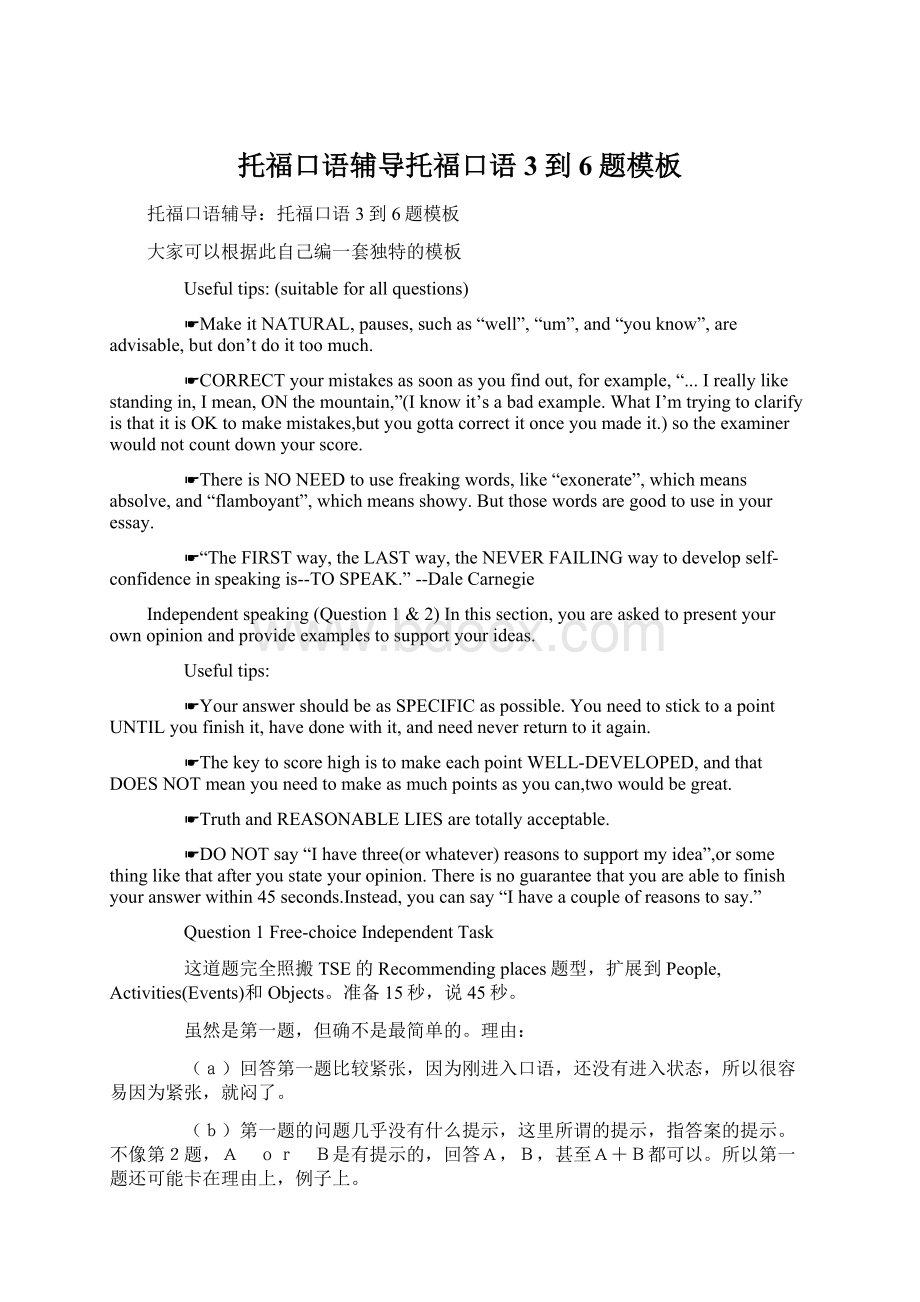托福口语辅导托福口语3到6题模板.docx
《托福口语辅导托福口语3到6题模板.docx》由会员分享,可在线阅读,更多相关《托福口语辅导托福口语3到6题模板.docx(15页珍藏版)》请在冰豆网上搜索。

托福口语辅导托福口语3到6题模板
托福口语辅导:
托福口语3到6题模板
大家可以根据此自己编一套独特的模板
Usefultips:
(suitableforallquestions)
☛MakeitNATURAL,pauses,suchas“well”,“um”,and“youknow”,areadvisable,butdon’tdoittoomuch.
☛CORRECTyourmistakesassoonasyoufindout,forexample,“...Ireallylikestandingin,Imean,ONthemountain,”(Iknowit’sabadexample.WhatI’mtryingtoclarifyisthatitisOKtomakemistakes,butyougottacorrectitonceyoumadeit.)sotheexaminerwouldnotcountdownyourscore.
☛ThereisNONEEDtousefreakingwords,like“exonerate”,whichmeansabsolve,and“flamboyant”,whichmeansshowy.Butthosewordsaregoodtouseinyouressay.
☛“TheFIRSTway,theLASTway,theNEVERFAILINGwaytodevelopself-confidenceinspeakingis--TOSPEAK.”--DaleCarnegie
Independentspeaking(Question1&2)Inthissection,youareaskedtopresentyourownopinionandprovideexamplestosupportyourideas.
Usefultips:
☛YouranswershouldbeasSPECIFICaspossible.YouneedtosticktoapointUNTILyoufinishit,havedonewithit,andneedneverreturntoitagain.
☛ThekeytoscorehighistomakeeachpointWELL-DEVELOPED,andthatDOESNOTmeanyouneedtomakeasmuchpointsasyoucan,twowouldbegreat.
☛TruthandREASONABLELIESaretotallyacceptable.
☛DONOTsay“Ihavethree(orwhatever)reasonstosupportmyidea”,orsomethinglikethatafteryoustateyouropinion.Thereisnoguaranteethatyouareabletofinishyouranswerwithin45seconds.Instead,youcansay“Ihaveacoupleofreasonstosay.”
Question1Free-choiceIndependentTask
这道题完全照搬TSE的Recommendingplaces题型,扩展到People,Activities(Events)和Objects。
准备15秒,说45秒。
虽然是第一题,但确不是最简单的。
理由:
(a)回答第一题比较紧张,因为刚进入口语,还没有进入状态,所以很容易因为紧张,就闷了。
(b)第一题的问题几乎没有什么提示,这里所谓的提示,指答案的提示。
不像第2题,A or B是有提示的,回答A,B,甚至A+B都可以。
所以第一题还可能卡在理由上,例子上。
第一题的出题范围分为四个方面:
1.地点类(place)
ex:
Describeyourfavoriteplaceinthecityandexplainwhyyoulikethisplace.(2006/1/6)(2006/7/15)
2.事情或活动类(eventoractivity)
ex:
Describethemostimportantdecisionyouhavemadeinyourlife.(2005/12/2)
3.人物类(person)
ex:
Describeyourfavoriteteacherandexplainhowthisteacherinfluencedyou.
4.物体类(objects)
ex:
Describethebest/worstinventioninthe20thcenturyandexplainhowitaffectsyourlife.
1、要言之有物,不要空喊口号,客观表达!
2、要扣题评述,表达主观意见(正面)。
3、要以面带点,不可纵向深入,因为:
(1)铺开表达可以灵活搭配事先背诵的小点,不被具体题目限定。
(2)可以在句式结构上套用模板,沉着应对,并给人逻辑清晰的印象。
(3)可避免纵向层面语汇短缺所引起的错误表达。
(4)可避免不经意间走题。
Youranswercangolikethis:
“Personally,Iwouldhavetosaythat,um,myfavorite...is....Andthereareacoupleofreasonstoname.Themostimportantthingisthat,youknow,....What’smore,....Sothat’swhy....”
Question2Paired-choiceIndependentTask
Q2相对于Q1来说,好回答的多。
Q2的问题是:
AorB,why?
或者doornotdo?
再或者A,B,C...whichoneprefer?
这道题完全照搬TWE题型。
准备15秒,说45秒。
1、同样建议以面代点,不要纵向深入。
2、四种Reasoning:
(1)CoreNodeReasoning
(2)"DevouringtheOpposition"Reasoning
(3)Counter-exampleIllustrationReasoning
(4)Blocking(Decliningtogiveopinion)
所以对于回答Q2,充分利用题干的提示,迅速作出选择,其实一但做了选择,问题就又回到Q1的解答方法了。
下面看几个真题:
(1)电视对于现代社会有正面作用还是负面作用,选择其中之一并解释原因
这是AorB
(2)Doyouthinkthehighschoolshouldteachmusicandartasotherbasicscience?
这是doornotdo
(3)媒体(tv,internet….)和人(朋友,家长,同学)从哪方面你能学到更多的东西?
这是A,B,C...whichoneprefer?
回答技巧:
(1)迅速选择,不要犹豫,这个题目回答没有对错,能自圆其说就好。
(2)一旦选择,回答得思路可以回到Q1,句型,结构可以用一样的。
(3)当缺少理由时,可以用正面,反面回答得方法,可以充实理由库
ex:
Doyouthinkthehighschoolshouldteachmusicandartasotherbasicscience?
态度:
应该
理由1:
有助于培养学生的想象力
理由2:
(如果想出来正面理由)如果不上musicandart的坏处:
学生缺少想象力
这样一来,把一个理由分两个用
(4)建议用作文的题库来练习,选上述3种问法的题目来练,既能复习作文,也能练习口语。
把185里面的题目挑出来反复练习就可以了。
(5)Q1和Q2不是没有关系的,Q1准备的内容很多时候能用在Q2的题目上,所以多多练习,这样可以缩小准备的内容,争取把这些内容弄得滚瓜烂熟。
TASK2万金油式的回答
Itdependsondifferentstages.
Itdependsonone’sabilities.
Itdependsonone’spersonality.
Itdependsonthenatureofthesubject.
Thisisquiteacomplexquestion.
Itdependson…….
Ifyou…….Forexample……,you’dbetter……inorderto…….
Ontheotherhand,if……,forexample……,you’dbetter……inorderto…….
AsfarasI’mconcerned,……(观点).Firstly,…….
Also,…….
What’more,…….
SoI’dratherchoose…….
Ex:
Somestudentsstudyforclassesindividually.Othersstudyingroups.Whichmethodofstudyingdoyouthinkisbetterforstudentsandwhy.
Youranswercangolikethis:
“Well,inmyopinion,Iwoulddefinitelyagreewiththepointthat,um,....
ThefirstreasonthatIwannasayisthat....Moreimportantly,....So,
uh,that’swhyIchoose...forthetworeasonslistedabove.”
“Well,inmyopinion,Iwoulddefinitelyagreewiththepointthat,um,....
ThefirstreasonthatIwannasayisthat....Moreimportantly,....So,
uh,that’swhyIchoose...forthetworeasonslistedabove.”
第一、二题Self-AssessmentChecklist:
1.Ireadthequestioncarefully.
2.Iusedcarefulplanningtooutlinemyresponse.
3.Ibeganwithatopicstatement.
4.Iusedstrongsupportingideas.
5.Iusedtransitionstoconnectthesupportingideas.
Integratedspeaking(Question3,4,5&6)
Inthispart,youareaskedtoparaphrasetheman/woman’sattitude
first,andthenlistthereasonss/hegives.YouareNOTaskedtopresent
youropiniontowardsthisproblem.
Question3Dialogue-basedR-L-SIntegratedTask
这道题通常是关于universitypolicies,rulesorprocedures;universityplans;campusfacilitiesorqualityoflifeoncampus的一些新的变化,对话中的一个人支持或者反对这个变化,并且给出理由,题目的要求就是复述其中一人的观点并且列举出这个人的理由(注意:
不能说自己的观点!
)。
问题类似于“Statehisopinionandexplainthereasonshegivesforholdingthatopinion”。
读40-45秒(75-100words),听60-80秒,准备30秒,说60秒。
1、对话题型重要原则:
只听一个人!
2、基本上对话结构是Q&A,总是针对A来设计题目。
3、概括记录,以最佳复原效果为准。
(1)可用符号甚至中文,但确保不会换用“关键词”。
(2)省纸,正反四折,一张搞定。
(3)关键句阅读时可预见,内容预先记下,态度非正即反,不要靠当时具体去听,只标+,-号。
(4)Supportingpoints可标上数码,至少可以心理安慰。
(5)细节列举可放过,特别不要在细节列举遇到生词时懊恼抓狂。
其实这个题目比较好回答,基本上readingpassage就可以判断出很多内容,如到底是notice,message,proposal,迅速找到关键词,内容究竟讲什么。
听得时候重点听态度和支持或者反对的理由。
听的过程中要注意标上序号。
首先做出两个区域,MAN,WOMAN。
然后再确定主要说话人后,迅速记下实词:
名词和动词。
个别情况下为形容词。
最后利用另一个附和者进行附和的时间,稍微调整并补充笔记,使用模板。
Usefultips:
☛Inthereadingpart,DONOTwasteyourtimeontakingnotes,itisunnecessary.Justfigureoutwhattheannouncementismainlytalkingabout,youdonotneedtosayanythingaboutitafterall.
☛Whenlistening,justwritedownTHREEmajorpoints--attitude,reason1&reason2.Youcanuse“+”and“-”torepresentpositiveattitudeandnegativeattitude.
☛MakesurethatyougetALLthereasonsthattheman/womangives.Anythingmissedwillloweryourscore.
☛DONOTspendtoomuchtimeexplainingwhytheschoolhaspulloutthepolicy,simplewordswouldbefine.
☛DONOTspendtoomuchtimeretellingthe
Youranswercouldgolikethis:
“Theschoolhasimplementedanewpolicythat...dueto....Andtheman/womanholdsapositive/negativeviewtowardstheannouncement.
Thefirstreasons/hegivesisthat....Andthesecondoneisbasedonthefactthat....”
Fromthereadingmaterial,weknowthat(thecollege)isgoingto...
Obviously,theman/womanintheconversationthinksthatthisisagreat/badidea,duetothefollowingreasons..
Onereasonisthat…….Anotheris,…….
(万一有时间)Sothat'sallthereasonss/hehastoformthatopinion.(尽量记,听为主)
Inthereadingmaterial,
Thereisa/anannouncement/message/notice/proposalabout****(填入记下的关键词)
Theuniversity/collegeisgoingto****(稍稍展开下)
Inthelisteningmaterial,
Twostudentsdiscussaboutthe***(填入关键词)
Theman/womanisagainst/supportingthe***
Heorshefeelsunhappy/lesssatisfiedabout***
thinksthe***isunfair/inconvenient/unaffordable
forthefollowingreasons:
First,hethinks/says****
Also,hepointsoutthat****
Theman/woman’sopinionaboutSTHisthat…….
……………(选择方案型:
听选择的原因。
1.Firstly,theman/womanstatesthat…….
2.Andthenhe/shestatesthat…….)
……………(提出建议型:
听建议的利弊。
1.Firstly,theman/womantalksaboutthepositiveaspectofthisissue.He/shestatesthat…….
2.Ontheotherhand,theman/manalsotalksaboutthenegativeaspectofthisquestion.He/shepointsoutthat…….
Question4Lecture-basedR-L-SIntegratedTask
读和听一段学术方面(lifescience,socialscience,physicalscience,andthehumanities)的文章,thereadingpassage一般是概括和抽象的学术语言,thelecture给出具体的例子、反例或者应用。
题目一般是要求“applythemoregeneralinformationyouhavelearnedinthereadingtotheexamplesdiscussedinthelecture”。
读40-45秒(75-100words),听60-80秒,准备30秒,说60秒。
1、Lecture题型其实只要求在阅读预见内容的前提下复述讲话框架。
2、记录内容取舍很有弹性,下面两者取其一:
(1)对数字敏感的记录数字及准确的相关含义,用以占据篇幅,避免连贯性动作描述。
(2)记录连贯性动作描述,避免具体数字及准确的相关含义的表述。
此题型细分为两种题型:
1、二元正负类:
阅读材料中的关键句之一有两个对称并列的概念性词语(切记:
通常是动词!
)
(1)在阅读材料中找到两个关键词,听力材料必然围绕这两个关键词展开。
(2)在听力中迅速判断两大关键词的正负性质。
(3)根据两大关键词的正负性展开相关内容。
2、描述举例类:
阅读材料中的关键句之一对文章题目进行描述,如果不是定义句,此关键句经常在定义句附近。
(1)阅读时记下描述性的关键句,如果临近定义句,同时记下定义句。
(2)听到并记下举例内容,特别是与关键句匹配的信息。
(3)根据具体例子反推验证关键句,如阅读时未确定,则在听力中迅速判断,从两句中选中一句。
(4)整合阅读与听力笔记,套用句型,准备答题。
readingpassage:
主要记下抽象的词,和具体的定义;原理,和具体原理的内容等
listeningpassage:
主要记所举的example,study,orreasearch,注意这些和抽象的定义和原理的挂钩。
1.先听听力材料的前两句话,老师会给出所听内容的概括性介绍。
再结合阅读给出的概念。
2.再听举例说明。
其方法通常是举出扩展事例,举反例或是短文中概念的实际应用。
3.TIPS:
A.带着一个“概念是什么,现象是什么”的问题用35秒看完短文,然后用10S的时间,用2句话总结出短文所介绍的概念或现象(尽量用短文中的词汇)
B.听段子的时候,带着“老师用什么例子来进行说明”这个问题去听。
要听结构(1+2),还要听例子中涉及到的3个基本要素(实验对象,实验过程,实验结果)。
其中,实验过程要详细。
C.多记实词(N+V)以及数字与时间。
4.PATTERNS:
a)TOPICSENTENCE:
Theprofessortalksaboutthetheorythat…….
b)SUPPORTINGDETAILS:
He/shegivesone/twoexamplestoillustrate/explainsuchapoint.(接下来陈述实验对象,实验过程,实验结果)。
Usefultips:
☛FindtheKEYwordsassoonaspossibleandthenwritethemdown.Thisistomakesurethatyouwillknowwhattheprofessorisgonnatalkabout.
☛Payattentionto